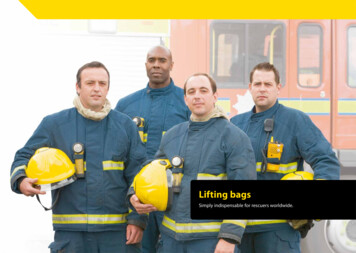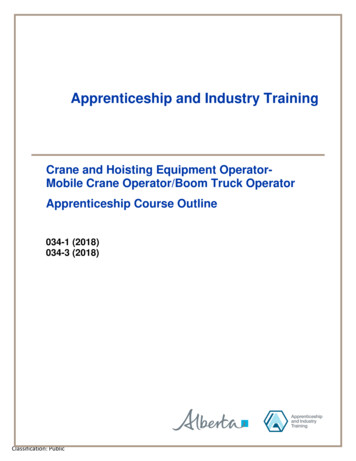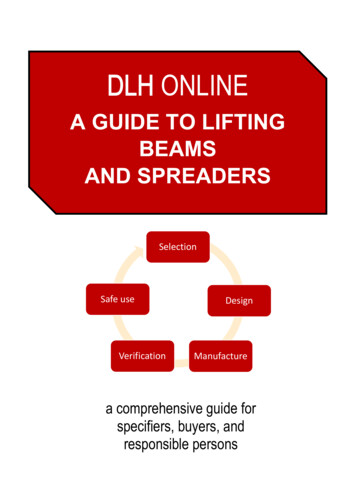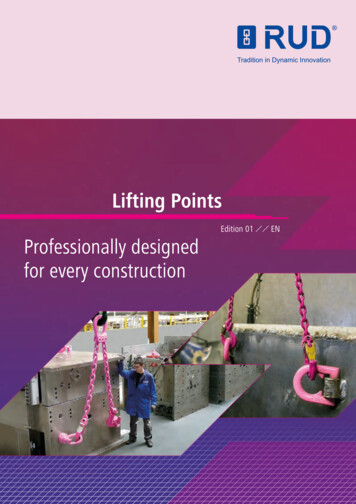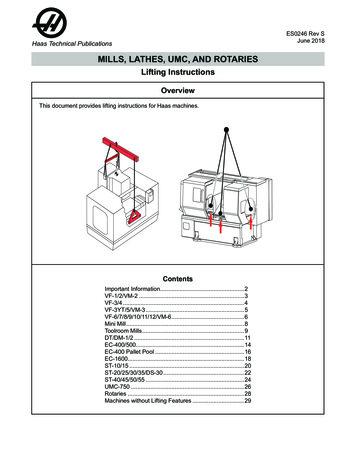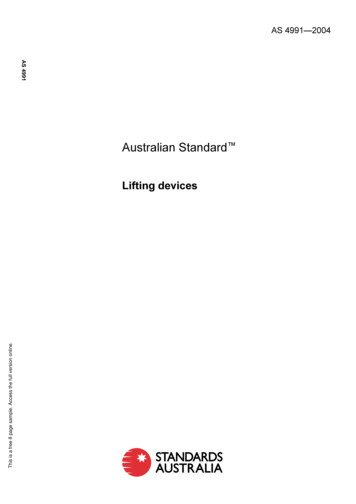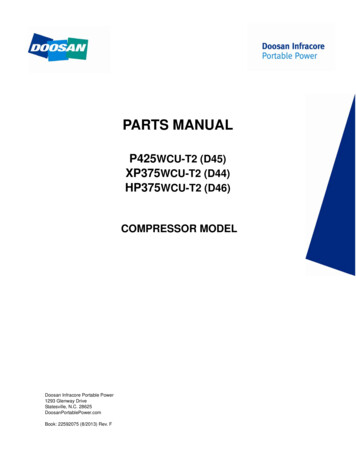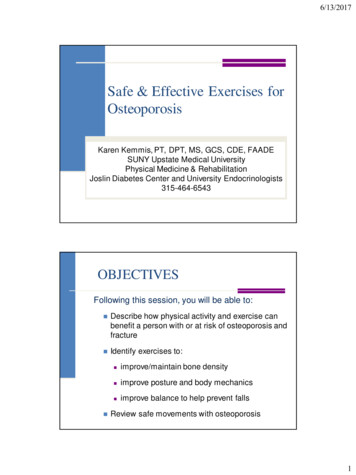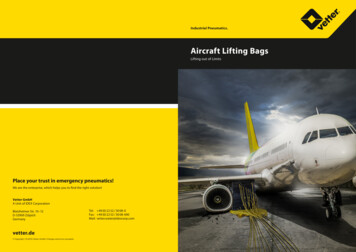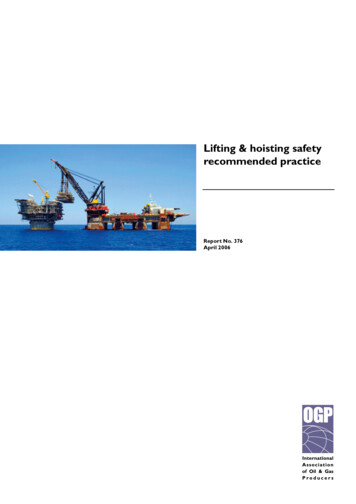
Transcription
Lifting & hoisting safetyrecommended practiceReport No. 376April 2006
PublicationsGlobal experienceThe International Association of Oil & Gas Producers has access to a wealth of technicalknowledge and experience with its members operating around the world in many differentterrains. We collate and distil this valuable knowledge for the industry to use as guidelinesfor good practice by individual members.Consistent high quality database and guidelinesOur overall aim is to ensure a consistent approach to training, management and best practice throughout the world.The oil and gas exploration and production industry recognises the need to develop consistent databases and records in certain fields. The OGP’s members are encouraged to use theguidelines as a starting point for their operations or to supplement their own policies andregulations which may apply locally.Internationally recognised source of industry informationMany of our guidelines have been recognised and used by international authorities andsafety and environmental bodies. Requests come from governments and non-governmentorganisations around the world as well as from non-member companies.DisclaimerWhilst every effort has been made to ensure the accuracy of the information contained in this publication, neither the OGP nor any of its members past present or future warrants its accuracy or will, regardless of its or their negligence, assume liability for any foreseeable or unforeseeable use made thereof, whichliability is hereby excluded. Consequently, such use is at the recipient’s own risk on the basis that any useby the recipient constitutes agreement to the terms of this disclaimer. The recipient is obliged to informany subsequent recipient of such terms.Copyright noticeThe contents of these pages are The International Association of Oil & Gas Producers 2006.All rights are reserved.
Lifting & hoisting safety recommendedpracticeReport No: 376April 2006
International Association of Oil & Gas ProducersAcknowledgementsThis recommended practice was produced by the OGP Lifting and Hoisting Task Force.Task Force members:ivAdams, RichieBROABowitz, CarstenOLFBrasic, MikeBPBurns, KennyMI-SWACODyngeland, Stein OveStatoilLawrie, GraemeSchlumbergerMacFarlane, JimHSEMekelburg, ThomasExxonMobilMorrien, AntoinShellParkinson, ChrisShellSmith, DonOGPSpackman, AlanIADCThompson, PeterBPVogelaar, JaapTotalWiggs, PhilipIMCAChairman 2006 OGP
Lifting & hoisting recommended practiceTable of contentsIntroduction . . . . . . . . . . . . . . . . . . . . . . . . . . . . . . . . . . . . . . . . . . . . . . . . . . . . . . . . . . . . . . . . . . . . . . . . . . . . . . . . . . 1OGP lifting and hoisting safety recommended practice . . . . . . . . . . . . . . . . . . . . . . . . . . . . . . . . . . . . . . . . . . . . 2Planning . . . . . . . . . . . . . . . . . . . . . . . . . . . . . . . . . . . . . . . . . . . . . . . . . . . . . . . . . . . . . . . . . . . . . . . . . . . . . . . . . . . . . . 3Control . . . . . . . . . . . . . . . . . . . . . . . . . . . . . . . . . . . . . . . . . . . . . . . . . . . . . . . . . . . . . . . . . . . . . . . . . . . . . . . . . . . . . . . 4Competence . . . . . . . . . . . . . . . . . . . . . . . . . . . . . . . . . . . . . . . . . . . . . . . . . . . . . . . . . . . . . . . . . . . . . . . . . . . . . . . . . . . 6Equipment . . . . . . . . . . . . . . . . . . . . . . . . . . . . . . . . . . . . . . . . . . . . . . . . . . . . . . . . . . . . . . . . . . . . . . . . . . . . . . . . . . . . 7Inspection, maintenance and certification . . . . . . . . . . . . . . . . . . . . . . . . . . . . . . . . . . . . . . . . . . . . . . . . . . . . . . . . 8Load integrity and stability . . . . . . . . . . . . . . . . . . . . . . . . . . . . . . . . . . . . . . . . . . . . . . . . . . . . . . . . . . . . . . . . . . . . . 9Lifting of personnel . . . . . . . . . . . . . . . . . . . . . . . . . . . . . . . . . . . . . . . . . . . . . . . . . . . . . . . . . . . . . . . . . . . . . . . . . . . 10Management system . . . . . . . . . . . . . . . . . . . . . . . . . . . . . . . . . . . . . . . . . . . . . . . . . . . . . . . . . . . . . . . . . . . . . . . . . . 11Glossary . . . . . . . . . . . . . . . . . . . . . . . . . . . . . . . . . . . . . . . . . . . . . . . . . . . . . . . . . . . . . . . . . . . . . . . . . . . . . . . . . . . . . 13Reference and good practice documents . . . . . . . . . . . . . . . . . . . . . . . . . . . . . . . . . . . . . . . . . . . . . . . . . . . . . . . . . 14Appendix 1: Example of lift categorisation scheme . . . . . . . . . . . . . . . . . . . . . . . . . . . . . . . . . . . . . . . . . . . . . . . 17Appendix 2: Example lift plan . . . . . . . . . . . . . . . . . . . . . . . . . . . . . . . . . . . . . . . . . . . . . . . . . . . . . . . . . . . . . . . . . . 19Appendix 3: Human factors . . . . . . . . . . . . . . . . . . . . . . . . . . . . . . . . . . . . . . . . . . . . . . . . . . . . . . . . . . . . . . . . . . . 20Appendix 4: Ten questions/the golden rule . . . . . . . . . . . . . . . . . . . . . . . . . . . . . . . . . . . . . . . . . . . . . . . . . . . . . . 22Appendix 5: Example responsibilities and competence table . . . . . . . . . . . . . . . . . . . . . . . . . . . . . . . . . . . . . . . 23Appendix 6: Example training matrix . . . . . . . . . . . . . . . . . . . . . . . . . . . . . . . . . . . . . . . . . . . . . . . . . . . . . . . . . . . 24Appendix 7: Example equipment registry . . . . . . . . . . . . . . . . . . . . . . . . . . . . . . . . . . . . . . . . . . . . . . . . . . . . . . . . 26Appendix 8: Example of recommended safety devices . . . . . . . . . . . . . . . . . . . . . . . . . . . . . . . . . . . . . . . . . . . . 27Appendix 9:Sample design, test, certification & inspection matrix . . . . . . . . . . . . . . . . . . . . . . . . . . . . . . . . . 28Appendix 10: Example colour coding system . . . . . . . . . . . . . . . . . . . . . . . . . . . . . . . . . . . . . . . . . . . . . . . . . . . . 30Appendix 11: Example pre-use inspection checklist . . . . . . . . . . . . . . . . . . . . . . . . . . . . . . . . . . . . . . . . . . . . . . 31Appendix 12: Example pre-use inspections forman-riding and work platform operations . . . . . . . . . . . . 33 2006 OGPv
International Association of Oil & Gas ProducersEssential Principles for Lifting & Hoisting OperationsPlanning A lift plan is required for every lift. If the lift deviates from the plan, make safe and stop the job. Hazard identification and risk assessment are an integral part of planning a lift. An assessment of the lift and determination of the lift method, equipment and number of people required arecritical to planning of the lift.Control One person in the lift team shall be designated as the person in charge of the lifting operation (referred toas PIC). The PIC shall review the lift plan and ensure that the required controls are in place and the lift is carried outfollowing the plan. The PIC ensures that the lift team has tested and understood visual or radio communications prior to the lift. All personnel involved in the lifting operation shall have their individual responsibilities clearly allocated. All people shall be kept clear of overhead loads and areas of potential impact. Manual load handling shall not be used to stop a swinging load and shall only be performed below shoulder height.Competence All persons involved in planning/performing lifting and maintaining lifting equipment shall be trained andcompetent for their role. Refresher training and periodic assessment is necessary to assure competence.Equipment Equipment shall be fit for its intended purpose and operating conditions and shall be designed to a recognized standard. Equipment shall be fitted with appropriate safety devices. Any safety devices installed on lifting equipment shall be operational and not over-ridden.Inspection, maintenance and certification Equipment integrity shall be maintained, supported by an equipment register. Lifting devices and equipment shall undergo detailed/thorough examination by a competent person at leastevery 12 months, and at least every 6 months for equipment used to lift people. All lifting devices and equipment shall be visually examined before use.Load integrity and stability Load shall not exceed dynamic and/or static capacities of the lifting equipment The integrity and stability of loads shall be verified before lifting,Lifting of personnel Lifting of personnel shall be avoided unless the risk has been demonstrated as being as low as is reasonablypracticable. Lifting of personnel shall be according to a specific personnel lift plan for that lift. Lifted personnel shall be properly secured with lanyards unless written procedures and risk assessmentrequire otherwise.Management system Lifting operations will be conducted in accordance with a documented Management System.vi 2006 OGP
Lifting & hoisting recommended practiceIntroductionBackgroundLifting and hoisting operations are one of the major causes of fatalities and serious incidents in global Exploration andProduction (E&P) activities. Every type of lift has a set of risks that need to be managed if the lift is to be undertakenin a safe and efficient manner.Despite the vast number of regulations, standards and guidelines that apply to lifting, incidents continue to occur. Togive the E&P industry a clear focus on this issue, the International Association of Oil & Gas Producers (OGP) SafetyCommittee Task Force on Lifting and Hoisting has developed this Recommended Practice (RP) document. This RPis based on current experience and best practice for preventing fatalities and serious incidents.It is the E&P industry’s expectation that all companies conducting lifting activities have a management system thatincludes specific procedures based on a full assessment of the risks and control measures required.PurposeThe intent of this document is to bring about a significant reduction in lifting incidents among OGP member companies by highlighting the essential principles of safe lifting and encouraging their strict application to lifting andhoisting operations.This RP describes lifting and hoisting safety elements to be incorporated into a management system that is consistent with the OGP Guidelines for the development and application of a health, safety and environmental managementsystems (OGP report 210). In addition, the references listed provide further guidelines for lifting and hoisting safetyand good practice. These references can be found on the OGP website: http://info.ogp.org.uk/LiftingandHoisting/.ScopeIt is recommended that this guidance be applied to all mechanical lifting and hoisting activities in the E&P industry,except: Drilling crown block, travelling block and top drive operations; Goods and personnel elevators; Ship anchor handling, marine towing, and routine ship operations not directly associated with E&P activities(eg, ship maintenance); Earthmoving equipment and operations; Tree cutting & associated movement of lumber; Helicopter lifting operations; Fall protection and rope access equipment; Manual handling. 2006 OGP1
International Association of Oil & Gas ProducersOGP lifting and hoisting safety recommended practiceThis document may recommend practices supplemental to the requirements of local legislation. However,nothing herein is intended to replace, amend, supersede or otherwise depart from such requirements. In theevent of any conflict or contradiction between the provisions of this document and local legislation, applicablelaws shall prevail.DescriptionThis document sets out at a management level OGP’s recommended practice (RP) for mechanical lifting and hoisting.The RP is not intended to be a comprehensive and technical set of lifting procedures.The RP considers the eight key areas that control lifting and hoisting safety. For each area, essential principles arelisted first, followed by a more detailed explanation.Additional information in the form of appendices and a list of references include various documents that have beenrecommended to the Task Force as being examples of good practice for particular aspects of lifting and hoisting.These documents are written in the context of the relevant companies management systems, hence OGP and theOGP Lifting and Hoisting Task Force are not responsible for the documents, and the contributing company acceptsno responsibility for the use of the documents outside their original intended context. The documents are intendedas guides for organisations to implement the RP and to develop a management system where none exists or to refineexisting practices.ApplicationThis guidance applies to all mechanical lifting and hoisting activities in exploration, drilling, production, logistics,operations, maintenance, construction, decommissioning and abandonment in both the onshore and offshore environment, except those specifically exempted in the Scope.This RP has been developed to be sufficiently generic and adaptable to different companies worldwide to gain theacceptance of their workforces. It is applicable to all parts of the E&P industry, including operators, contractors andsubcontractors.Certain specialist operations will require more rigorous controls due to the inherent hazards associated with the task.Examples of specialist operations are subsea lifts, lifting over live plant, lifts close to equipment capacity and environmentally sensitive lifts.TerminologyThe term lifting is used throughout this document to describe all types of lifting and hoisting.2 2006 OGP
Lifting & hoisting recommended practicePlanning A lift plan is required for every lift. If the lift deviates from the plan,make safe and stop the job.Hazard identification and risk assessment are an integral part of planning a lift.An assessment of the lift and determination of the lift method, equipmentand number of people required are critical to planning of the lift.Lift categorisationTo ensure that suitable controls are applied, lifting operations shall be categorised according to the level of risk andcomplexity. See Appendix 1 for an example of a lift categorisation scheme.Lift plansAll lifting operations shall have a lift plan supported by an analysis of the hazards and risks. Lift plans may be separatedocuments or can be part of other documents. The detail required is related to the risk and complexity of the lift.Frequent or routine tasks may only require a generic lift plan supported by an onsite risk assessment and team briefingwhereas other lifts may need significant engineering design effort. Generic lift plans may be appropriate for a series ofsimilar or routine lifts within specified limits but shall be formally reviewed and re-issued periodically.The lift plan shall clearly address, but not be limited to, the following: The type and number of personnel required, their specific roles and competences, and how they will be briefed; The nature and weight of the load and lifting points; Pick up and set down points and constraints such as space and stacking; Equipment required and certification checks; Step-by-step instructions; Communication methods to be used; Emergency and rescue plans; Restrictions on the lift such as weather, light, sea state, etc.; Access and egress for slinging and un-slinging the load; Simultaneous, conflicting or nearby operations or work; Whether Permit to Work procedures are applicable; Load integrity check; Load charts for generic lift plans and for heavy or complex lifts; An assessment of whether tag lines should be used, their hazards and limitations.An example lift plan is included as Appendix 2.Approval of lift plansAll lift plans shall be reviewed and approved by a competent person. The rigour of review shall be determined by thecategory of lift, which may require a qualified specialist engineer.Changes to lift plansAny change to a plan shall be approved as if it were a new plan. 2006 OGP3
International Association of Oil & Gas ProducersControl One person in the lift team shall be designated as the person in chargeof the lifting operation (referred to as PIC).The PIC shall review the lift plan and ensure that the required controlsare in place and the lift is carried out following the plan.The PIC ensures that the lift team has tested and understood visual orradio communications prior to the lift.All personnel involved in the lifting operation shall have their individualresponsibilities clearly allocated.All people shall be kept clear of overhead loads and areas of potentialimpact.Manual load handling shall not be used to stop a swinging load andshall only be performed below shoulder height.Person in Charge (PIC)The PIC has operational control of the lift. The PIC: Is designated as being in charge of coordinating, controlling and executing the lift; Reviews the lift plan and ensures that the required controls are in place; Ensures that the lifting equipment is inspected and appropriate for use; Checks that load integrity and stability is satisfactory; Ensures that people involved are competent for performing their task, aware of the task and procedures to befollowed, and aware of their responsibilities; Briefs people involved in or affected by the lift; Ensures the lift is carried out following the plan. Suspends the lift if changes or conditions (eg, wind) occur thatwould cause a deviation from the plan; Monitors the performance of all involved personnel to ensure that adequate standards of performance are maintained; Manages any special issues such as language barriers and new/inexperienced staff;. Checks that there is no deviation from standards for routine lifts; Shall allow for concurrent or simultaneous operations that may affect or be affected by the lift, eg, helicopteroperations, ballast control, other cranes.Legal AccountabilityThe PIC is not necessarily the same as the person with legal accountability.Conducting the lifting operationThe PIC shall ensure that lifting operations are conducted in strict accordance with the approved lift plan. Any variation from the agreed lift plan shall result in the job being made safe, stopped and reassessed to ensure continued safeoperation.The following are critical practices in conducting the lifting operation: The lifting appliance operator shall obey an emergency stop signal at all times, no matter who gives it. The load to be lifted shall be confirmed as within the rated capacity of the lifting equipment and attached bymeans of suitable lifting accessories. The operator of the lifting appliance shall not leave the operating controls while the load is suspended. Personnel shall not undertake more than one task at a time, eg the signaller shall not handle loads and signal atthe same time. All personnel and third parties shall be kept out of any area where they might be struck or crushed by a load orlifting equipment if it swings, shifts or falls. No one shall stand or work directly below a load. Physical barriersmay be required for this.4 2006 OGP
Lifting & hoisting recommended practice Operators shall never move a load directly over people. Personnel shall have an escape route in case of an unexpected movement of the load or equipment.Human factorsHuman factors are critical in safe lifting. People can make mistakes and may break rules. This shall be addressed inplanning and controlling lifting operations. Important human factors in lifting are culture/working environment,people, facilities/equipment and management system. Appendix 3 provides a more detailed discussion on the management of human factors in lifting. Use of a checklist such as one presented in Appendix 4 may prevent most errors.CommunicationBefore starting lifting operations the person in charge will hold a pre-job meeting to explain the lift plan to everybodyin the lift team, confirm their understanding of the plan and the hazards involved. Particular attention needs to beplaced on proving the effectiveness of communications for blind lifts.When lifting operations need to be controlled by signals, a designated signal person (signaller) shall be assigned.Signals between the lifting appliance operator and the signaller (sometimes referred to as Banksman or Flagman)shall be discernable – audibly or visually – at all times. When using radio communication, continuous verbal instruction shall be used. The operator shall stop whenever there is no clearly understood signal.The PIC and the designated signal person shall be made known to the lift team and to personnel in the proximity tothe lift. The signaller shall be clearly identified, preferably by distinctive clothing. The agreed signalling systems shallbe clearly displayed on-site and available to all those involved in lifting operations.In order to facilitate good communication, it is important that personnel involved in the lifting operation are notdistracted. With this in mind, the use of mobile phones or other devices unrelated to the lift should be restricted.Roles and responsibilitiesSite Manager: Has overall responsibility for the site and for applying safety management systems; Authorises or designates a PIC who has the required competence and will be positioned on site to control thelift safely; Authorises or designates lifting equipment operators.Signaller:Where required, is designated by the PIC; Is the sole signaller at any given time; Has direct line of sight of the load; Adheres to a clear process, including confirmation of handover by PIC and operator, if a handover to anothersignaller is required; Does not handle rigging duties simultaneously.Lifting Appliance Operator: Shall have authorization to use the equipment; Is responsible for pre-use inspection of the lifting appliance; Is responsible for using the equipment properly.All involved personnel Shall understand their role and be competent to do it. Shall inform the PIC if conditions change or if there are safety concerns during the lift.Slinger/Load Handler Works under the direction of the PIC to (un)sling and handle loads. 2006 OGP5
International Association of Oil & Gas ProducersCompetence All persons involved in planning/performing lifting and maintaining lifting equipment shall be trained and competent for their role.Refresher training and periodic assessment is necessary to assure competence.The management system shall define the standards required for critical roles and the process for assuring the competence of those involved in planning and executing lifting operations. Generally, to be regarded as competent a personshall have received the necessary training and subsequently demonstrated their ability to perform at the requiredlevel in the field. An example of basic competence requirements is given in Appendix 5. The system shall allow thePIC to easily confirm personnel competence. To facilitate this, records of competence shall be available on site, andif practicable on the person.Periodic assessment (preferably every two years, but normally not longer than four years) and refresher training shallbe conducted as necessary to ensure the required level of performance is maintained.Equipment specific training will be necessary for certain operations. An example training matrix has been includedas Appendix 6.Additional considerations are: Formal certification shall always comply with legislative and management system requirements; When technical authorities or advisors are used, their roles shall be defined in the management system and theyshall have the required level of competence and access to specialist advice; Companies should consider the relevance and benefits of simulator training for crane operators.6 2006 OGP
Lifting & hoisting recommended practiceEquipment Equipment shall be fit for its intended purpose and operating conditionsand shall be designed to a recognized standard.Equipment shall be fitted with appropriate safety devices.Any safety devices installed on lifting equipment shall be operationaland not over-ridden.Lifting equipment comprises lifting appliances (equipment performing the lifting), lifting accessories (devices thatconnect the load to the lifting appliance) and lifted equipment (eg, containers, baskets, etc). All shall be marked withthe safe working load (SWL) or working load limit (WLL) and identification number. An equipment register, including maintenance records and evidence of certification shall be available onsite. A sample equipment register format isincluded as Appendix 7.Equipment minimum standardsTo ensure that equipment is fit for purpose, local controlling documentation shall specify design, certification, storage, maintenance and inspection criteria in accordance with a recognized industry standard and/or manufacturer’srecommendations. The manufacturer or an approved body shall issue a certificate or a letter of conformance to theappropriate standards. An example of minimum safety device requirements is provided in Appendix 8.Procurement (services and equipment)The manufacturer or service provider shall supply all lifting equipment with documentation that defines the permissible operating conditions, design criteria, documentation of testing, maintenance and operation manuals, andexamination/inspection requirements. Pre-used equipment shall also be supplied with operations and maintenancehistory, including records of any incidents, overload, damage, major repairs, modifications or limitations arising fromprevious use. In addition, critical powered lifting appliances such as cranes, shall be supplied with Failure ModeAnalysis and criticality information.Clients and service providers shall ensure that there is a clear mutual understanding of the scope of the servicesrequired, which may range from equipment supply to a comprehensive design and execution of lifts.All lifting accessories and lifted equipment shall be designed, manufactured, inspected, tested and certified in accordance with applicable international standards and industry accepted codes of practice. Engineered lifting accessories(eg, spreader bars) shall be designed, manufactured, and tested in compliance with the intent of the relevant industrystandards. Any lifted equipment not certified to an acceptable code shall be structurally verified by a qualified engineer and load tested. Appendix 9 is an example design, test, certification and inspection matrix.Ergonomics shall be considered in the design of lifting equipment to ensure ease of operation and to reduce or eliminate potential human factor problems with human/machine interfaces. Special consideration shall be given to minimise noise and vibration, address temperature extremes, encourage good control layout and optimise lines of sightand aid communication.Specific equipment issues The appropriate load-radius chart for the lifting appliance configuration in use shall be visible to the operator.ISO shipping containers are not designed for and therefore not suitable for offshore crane dynamic lifts.All engineered lifting points shall be certified.Suspension points for sheaves in winch systems shall be rated to withstand the maximum credible winch pull.Hook selection shall minimise the possibility of fouling. 2006 OGP7
International Association of Oil & Gas ProducersInspection, maintenance and certification Equipment integrity shall be maintained, supported by an equipmentregister.Lifting devices and equipment shall undergo detailed/thorough examination by a competent person at least every 12 months, and at leastevery 6 months for equipment used to lift people.All lifting devices and equipment shall be visually examined before use.The maintenance schedule shall be based on manufacturer’s recommendations, operating experience, applicablestandards and failure modes. The schedule shall integrate preventative and predictive maintenance techniques.Maintenance schedules shall consider the effects of ageing and equipment utilization. Safety critical components andsystems shall be identified and arrangements made to ensure they are adequately maintained. Where third partiesprovide their own lifting equipment, the Site Manager shall ensure that there is an auditable system that ensures thecontrol, integrity and suitability of the equipment.To ensure the integrity of lifting equipment, it shall be subject to a detailed/thorough examination by a qualifiedinspector who has sufficient detailed knowledge of its design, operation and failure modes to recognise significantdefects. The scope, methods and standards of that examination, and acceptance/rejection criteria shall be specified forall equipment (refer to Appendix 9 for example), taking into account the following: Legal requirements; Manufacturer’s recommendations; Operating conditions (including infrequently used and mothballed equipment); Utilisation and age of the equipment; Degree of risk; Results of previous inspections.This examination will normally require some dismantling of the equipment to expose the critical working parts.Frequency of examination shall not be longer than 12 months (6 months for equipment used in personnel lifting), ormore often if required by legislation. Colour coding can be a useful aide in controlling this. Where possible, colourcoding should be standardised across operator and contractors in the same operational area. For an example colourcoding scheme, see Appendix 10.Testing of lifting equipment will be dependent on the type and configuration of the equipment and whether theequipment is temporarily or permanently installed. On installation, equipment shall undergo a comprehensive test toprove its integrity. This may involve proof or overload testing under controlled supervised conditions.Equipment that has been involved in any of the following shall be thoroughly examined: An incident (liftin
This RP describes lifting and hoisting safety elements to be incorporated into a management system that is consist-ent with the OGP Guidelines for the development and application of a health, safety and environmental management systems (OGP report 210). In addition, the references listed provide further guidelines for lifting and hoisting safety

